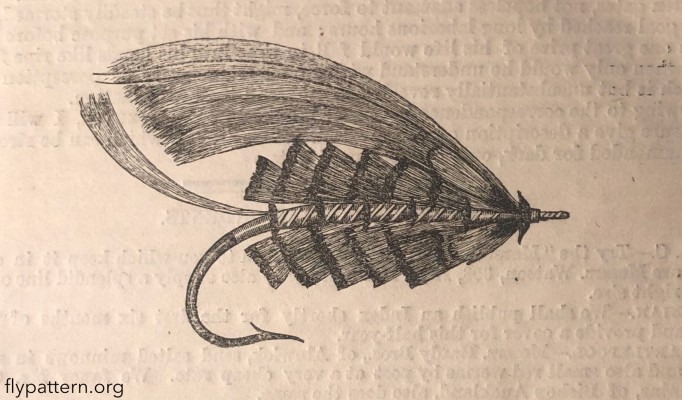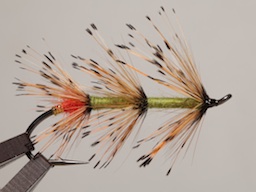From "The fishing gazette" - July 12th, 1884
WITH reference to dyed hackles, it would be absurd not to admit they are cheap and convenient, and that, in many instances, we cannot dispense with them; at least, until something more suitable is introduced. Fourpence per dozen all round cannot be said to be an exorbitant demand, but it is questionable whether in the end they are not more costly than "naturals." The numberless shades that may be purchased are almost unending in variety and tone. We may be told-and, indeed, it is often asserted - that the colours are fast, that, by some heoretical process, they must be so; but after four-and-twenty hours' practical experience we invariably find this a mistake. Perhaps oranges and yellows under the influence of acids last longest; but what can be worse than a washy blue, or generally better than a brilliant one? not that this applies to other colours, because a staring scarlet, for instance, is often better for a little toning down, except when the water is very clear; then, as I have urged before, our colouring should be very bright.
The Vulturine guinea-fowl affords a splendid blue hackle, long or moderately short; it never seems to fade unless exposed to the sun; it plays beautifully in the water, and maintains its colour when in use. The light blue Macaw is a trifle more brilliant, but the fibre is coarser and consequently not so elastic in the water; and the Jay is our recognised friend, but a little of it goes a long way, and flies are too frequently overburdened with this favourite feather.
If harmony were maintained there should be no difficulty for dyers to produce three or even four consecutive colours in a hackle; say, for example, 1/2in. of golden yellow for the point, then the same space for red claret, following with orange and the rest blue. This feather would be a novelty, and one most useful to us; it would save time, trouble, and expense, for a fly of such description would only take one instead of four hackles.
What is there that can boast of such a wide assortment of colour in so small a space as a salmon fly? And, therefore, is not harmony of the greatest importance to us? The metaphysician will speculate and advise there is no such thing as colour, that what we call red is merely a sensation produced in the mind by a wave of light, in much the same way as a wave of sound is changed into a musical note. Some, indeed, assert that an atmospheric vibration produces simultaneously a sensation of colour and music, and consciously or unconsciously the one cannot occur without the other. Such theories, however, find little favour with the practical colourist. To him the harmony of colours is merely of combinations of primary, secondary, and tertiary pigments; and he has little sympathy with the scientist who would rob him of the old red, yellow and blue primaries for the comparatively useless substitutes of violet and green, &c. The student should strive in such a way to arrange that, while each colour is shown to its fullest advantage, it is enhanced in beauty by proximity to the one next to it; and this is equally applicable to seals' furs as well as hackles.
In reference to this week's illustration, "Tippetiwitchet" presents an attractiveness that can scarcely be surpassed. It is elaborately designed, and like those which preceded it, harmoniously coloured; indeed, one other excellent specimen of our "Chiefs" most golden and treasured fancies. It is, in short, a fly which will be sure to pique the curiosity of many a springfisherman.
Perfection in fly dressing is the essence of an angler's life, and I have heard it said almost the end of his ambition. We can, however, only be led to perfection by the gentle hand of Time. None of our flies are infallible - if so, the charm of fishing would be irretrievably lost; but we may often, when inventing, feel lifted above our-selves when we attain a point we had never reached before.
In describing this fly, which as heretofore I have been able to do without the aid of standard colours, I begin as usual with the
Tag: Silver twist, and light blue silk the same colour as a light blue chatterer.
Tail: A topping.
Butt: Black herl.
Body: In five equal divisions, each terminating with a black herl butt. There are four tippets; two (back to back) tied in top and bottom of every section as illustrated over the golden floss which, silk is the same shade as the golden toppings.
Ribbed: Oval tinsel.
Throat: Blue chatterer feather (as shown).
Wings: Five or six toppings, according to size of hook.
Cheeks: Blue chatterer.
Horns: Blue Macaw.
Head: Black herl
I venture to state there is no fly in this valuable collection that requires more care in dressing; the parallelism, and the coextension of the tippets being most important and the quill of each must be tied on so that the feather matches and rests gently against it mate. To effect this by mean manipulation after the body is finished - should any of them project - would be of no earthly use, because after a very few minutes' wear they would reassume their blundering and bulging position merely to skirt the water and scare the fish. It would be of no importance practically what deformity faultlessly-made Tippetlwitchets might assume by negligence in drying, because the bilateral symmetry of the tippets would be renewed in a moment when wetted again, on which occasion they would readily trim and ish as well, if not better, than ever.
In my opinion the easiest plan for previously managing these tippets is to hold them at about an angle of 45 degrees flat, lenthways, and fibres upwards between the thumb and forefinger of the left hand, having its palm towards you. The quill of hte feather is now projecting below for indentation by the right thumb nail which - to show its correct position - could carry a foupenny-piece through the entire process.
The right hand is stationary, and pressing the quill against its forefinger with the thumb nail; and while so engaged, if the left elbow only is raised, say a foot, the dent for the tying silk will be properly shaped and completed; then it would be difficult to fix these feathers incorrectly from that point.
For the side of the hook facing you in the illustration, the upper or face of the feather should be held against the left thumb, and for the other side of the hook against the left forefinger.
Attention by the student to these and similar details would pave the way and make the high and pleasant road to prefection somewhat easier of access. The golden gates, not hopeless adament to force, might thus be steadily stomred, and the goal reached by long laborious hours; and with his set purpose beofre him, this one great prize of his life would fall in time into his hands like ripe fruit, and then only would he understand with an unerring surety of perception taht which is but unsubstantially revealed to others in their imagination.
Owing to the correspondence in former numbers of the GAZETTE, I will with pleaseure give a description of the "Black Prince" next, which can be strongly recommended for dark, or porter-coloured water.
|

